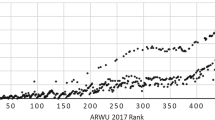Abstract
Thomson Reuter’s highly cited database (HiCite) (http://www.highlycited.com) is composed of the top researchers in several subspecialties belonging to the 22 essential science indicator fields of the web of science. By analyzing the data collected, we are able to calculate several correlations in the data based upon select areas, view trends of changes in rank, percentage of contribution, and countries, and re-rank the organizations by new standards. The purpose of this is to refocus and highlight previously unaccounted but significant details that are historically ignored, such as economics, specialties, nationality, efficiency, and field, and to evaluate performance of the separate organizations by multiple factors, with an emphasis on the status of the United States of America.
Similar content being viewed by others
References
Adler, R., John, E., & Peter, T. (2009). Citation statistics. Statistical Science Statist. Sci. 24.1, 1–14. Math Union. International Mathematical Union. 16 Jan 2016. http://www.mathunion.org/fileadmin/IMU/Report/CitationStatistics.pdf.
Alonso, S., Cabrerizo, F. J., Herrera-Viedma, E., & Herrera, F. (2009). h-Index: A review focused in its variants, computation and standardization for different scientific fields. Journal of Informetrics, 3, 273–289. doi:10.1016/j.joi.2009.04.001.
ARWU. (2014). Methodology. Academic Ranking of World Universities. The Shanghai Ranking, n.d.16 Jan 2016. http://www.shanghairanking.com/ARWU-Methodology-2014.html.
Bhattacharjee, Y. (2011). Saudi Universities offer cash in exchange for academic prestige. Science 334.6061, 1344–345. http://www.sciencemag.org/content/334/6061/1344.full.
Bornmann, L., & Bauer, J. (2015). Evaluation of the highly-cited researchers’ database for a country: Proposals for meaningful analyses on the example of Germany. Scientometrics, 2015, 2015. doi:10.1007/s11192-015-1619-1.
Bornmann, L., & Johann, B. (2015). Which of the World’s Institutions employ the most highly cited researchers? An analysis of the data from highlycited.com.” Journal of the Association for Information Science and Technology, 66(10), 2146–2148, First published online:8 Jan 2015.
Bornmann, L., Mutz, R., Neuhaus, C., & Daniel, H. D. (2008). Citation counts for research evaluation: Standards of good practice for analyzing bibliometric data and presenting and interpreting results. ESEP, 8, 93–102. doi:10.3354/esep00084.
Best Medical Schools|Top Medical Schools|US News Best Graduate Schools—US News. US News RSS. US News, n.d. 01 Aug 2015. http://grad-schools.usnews.rankingsandreviews.com/best-graduate-schools/top-medical-schools.
Chen, S., Yves G., Clément A., & Vincent L. (2014). Interdisciplinarity patterns of highly-cited papers: A cross-disciplinary analysis. Proceedings of the American Society for Information Science and Technology 51.1, 1–4. Proceedings of the American Society for Information Science and Technology, 24 Apr. 2015. 23 Jan 2016. https://www.asis.org/asist2014/proceedings/submissions/posters/257poster.pdf.
Chen, S., Clément A., & Vincent L. Are top-cited papers more interdisciplinary?” Are Top-cited Papers More Interdisciplinary? Journal of Informetrics, Oct. 2015. 23 Jan 23 2016. http://www.sciencedirect.com/science/article/pii/S1751157715300201.
Docampo, D. On the Effects of Institutional Size in University Classifications: Th.” E Case of the Shanghai Ranking. Scientometrics, 27 Nov. 2014. 16 Jan 16 2016. http://link.springer.com/article/10.1007/s11192-014-1488-z.
Docampo, D., Egret, D., & Cram L. (2016) The Effect of University Mergers on the Shanghai Ranking. Springer. Scientometrics, 3 Apr. 2015. 16 Jan 2016. http://link.springer.com/article/10.1007/s11192-015-1587-5/fulltext.html.
Gingras, Y. How to Boost Your University up the Rankings—University World News.” RSS. University World News, 18 July 2014. 16 Jan 2016. http://www.universityworldnews.com/article.php?story=20140715142345754.
Glanzel, W., & Schubert, A. (2003) A new classification scheme of science fields and subfields designed for scientometric evaluation purposes. Scientometrics. ArXiv 56.3, 357–67. Mar. 2003. 16 Jan 2016. https://www.researchgate.net/publication/46430000_A_new_classification_scheme_of_science_fields_and_subfields_designed_for_scientometric_evaluation_purposes_Scientometrics_563_357-367.
GDP. (current US$). GDP (current US$). The World Bank, n.d. 01 Aug 2015. http://data.worldbank.org/indicator/NY.GDP.MKTP.CD.
Highly Cited Researchers. (2001). Highly Cited Researchers. Thomson Reuters, n.d. 01 Aug 2015. http://highlycited.com/?dtyear=2011.
Highly Cited Researchers. (2014). Highly Cited Researchers. Thomson Reuters, n.d. 01 Aug 2015. http://highlycited.com.
Home. (2015). Complete University Guide. The Complete University Guide, n.d. 01 Aug 2015. http://www.thecompleteuniversityguide.co.uk/.
Ioannidis, J. P. A., Patsopoulos, N. A., Kavvoura, F. K., Tatsioni, A., Evangelou, E., Kouri, I., Despina, G., Contopoulos-Ioannidis, & Liberopoulos, G. International Ranking Systems for Universities and Institutions: A critical appraisal. BMC Medicine. BioMed Central, 25 Oct. 2007. 16 Jan 2016. http://www.ncbi.nlm.nih.gov/pmc/articles/PMC2174504/.
Lillquist, E., & Green, S. (2010). The discipline dependence of citation statistics. Scientometrics, 84, 749–762. doi:10.1007/s11192-005-0240-0.
Malesios, C. C., & Psarakis, S. (2012). Comparison of the h-index for different fields of research using bootstrap methodology. Quality & Quantity, 48, 521–545. doi:10.1007/s11135-012-9785-1.
Methodology|Highly Cited Researchers. Highly Cited Researchers. Thomson Reuters, n.d. 09 Jan 2016. http://highlycited.com/methodology.
Myklebust, JP. Meet the World’s 3,215 Hottest Researchers—University World News.” RSS. University World News, 28 June 2014. 16 Jan 2016. http://www.universityworldnews.com/article.php?story=20140626174600925.
Podlubny I. Comparison of scientific impact expressed by the number of citations in different fields of science. Scientometrics, 64, 95–99. http://dx.doi.org/10.1007/s11192-005-0240-0.
Podlubny, I., & Kassayova, K. (2006). Towards a better list of citation superstars: Compiling a multidisciplinary list of highly cited researchers. Research Evaluation, 15, 154–162. doi:10.3152/147154406781775887.
Pyykko, P. Power-law distribution of individual Hirsch indices, the comparison of merits in different fields, and the relation to a Pareto distribution. arXiv:physics/0608282, http://arxiv.org/abs/physics/0608282.
Taiwan GDP. Taiwan GDP. Trading Economics, n.d. 16 Jan 2016. http://www.tradingeconomics.com/taiwan/gdp.
Total Population (in Number of People). Total Population (in Number of People). The World Bank, n.d. 01 Aug 2015. http://data.worldbank.org/indicator/SP.POP.TOTL.
Uncovering Excellence in Academic Rankings: A Closer Look at the Shanghai Ranking.” ResearchGate. Scientometrics, 14 July 2009. 16 Jan 2016. http://www.researchgate.net/publication/220365426_Uncovering_excellence_in_academic_rankings_A_closer_look_at_the_Shanghai_ranking._Scientometrics_83(2)_515-524.
USA. National Center for Education Statistics. Institute of Education Sciences. N.p.: n.p., n.d. Final Release Data. 01 Aug 2015. https://nces.ed.gov/.
World University Rankings. (2014–15). Times Higher Education. Times, 01 Oct. 2014. 01 Aug 2015. https://www.timeshighereducation.co.uk/world-university-rankings.
Yegros, A., D’Este, P., & Rafols, I. Does interdisciplinary research lead to higher citation impact? The different effect of proximal and distal interdisciplinarity. ResearchGate. Plos One, 12 Aug. 2015. 23 Jan 2016. https://www.researchgate.net/publication/280999059_Does_Interdisciplinary_Research_Lead_to_Higher_Citation_Impact_The_Different_Effect_of_Proximal_and_Distal_Interdisciplinarity.
Author information
Authors and Affiliations
Corresponding author
Rights and permissions
About this article
Cite this article
Li, J.T. What we learn from the shifts in highly cited data from 2001 to 2014?. Scientometrics 108, 57–82 (2016). https://doi.org/10.1007/s11192-016-1958-6
Received:
Published:
Issue Date:
DOI: https://doi.org/10.1007/s11192-016-1958-6



